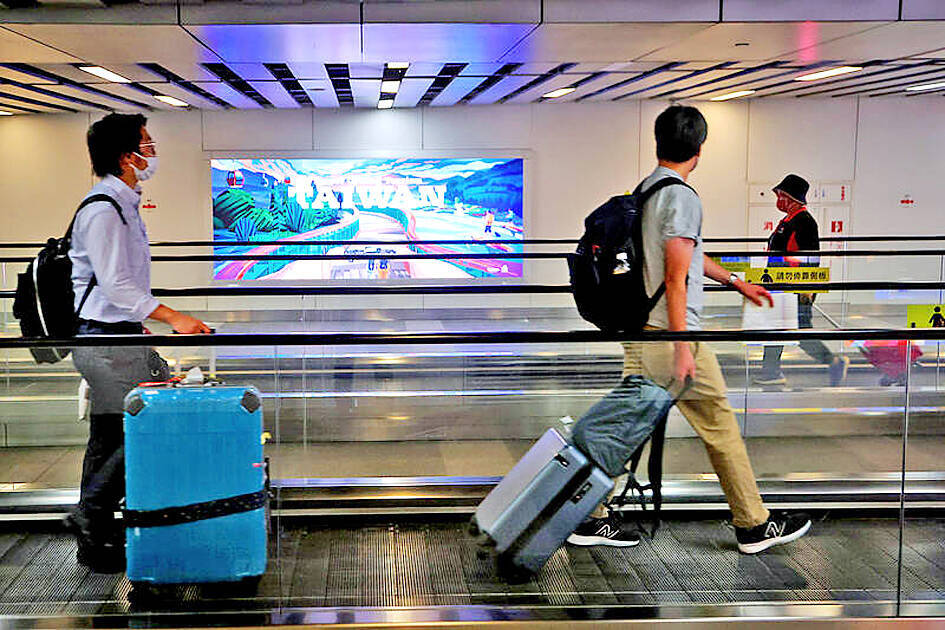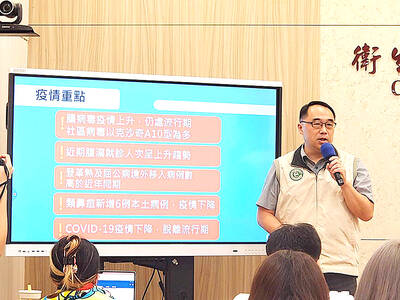Tourism officials are increasingly eyeing Southeast Asian tourists as a key to meeting the national target of attracting 10 million foreign visitors this year, recent government measures showed.
Southeast Asia is of great interest to officials, as Tourism Administration data showed that more than 2 million people from the region had visited Taiwan annually before the COVID-19 pandemic upended international travel. Southeast Asia’s growing economy and population also shows promise in bringing a high volume of big foreign spenders to Taiwan.
Taiwan-bound international travelers reached 10 million per year in 2015, with millions coming from China, Japan, Hong Kong, Macau and South Korea. However, as visitors from China declined sharply due to COVID-19 and political reasons, officials have shifted national policy focus to other markets to spread the risk.

Photo: CNA
Since the easing of COVID-19, Southeast Asia’s economy has taken off rapidly and the number of flights to Taiwan from the region has seen a big recovery.
Last year, 2,365,391 Southeast Asians visited Taiwan, about 91 percent of the pre-COVID-19 traffic volume, government records showed.
Singaporeans and Malaysians of Chinese descent used to account for majority of Southeast Asian visitors to Taiwan, but Filipinos have overtaken them, Tourism Administration Deputy Director-General Trust Lin (林信任) said.
Young men and women with relatively high income levels and a taste for adventure were mainly responsible for the increase, he said, adding that Taiwan had 467,000 Filipino visitors last year.
Local influencers shared favorable opinions of Taiwanese cuisine and culture on social media, while the 2001 Taiwanese TV drama Meteor Garden (流星花園) was a cultural phenomenon among middle-aged Filipinos, Lin said.
Filming locations of the TV drama, including the National Chung Cheng University in Chiayi, featured prominently in the itineraries of many Filipino tour groups, Lin added.
The government has also made inroads in certifying halal accommodations and restaurants to cater to Muslims from Indonesia and Malaysia, who remain important to the Taiwanese tourism industry.
The Tourism Administration provided foreign enterprises various incentives under the New Southbound Policy to encourage travel to Taiwan, officials said.
Last year, 136,000 people from nations targeted by the policy traveled to Taiwan in tour groups, accounting for 91 percent of foreign visitors who received subsidies, they said.
New Southbound Policy-related tourism generated NT$600 million (US$18.27 million) last year, and 16 tour groups — 2,000 people in total — have visited the nation in January and last month, they said.
Additionally, Tourism Administration Director-General Chou Yung-hui (周永暉) said subsidies for foreign enterprises were designed to attract high-income travelers to upscale hotels and restaurants.
For example, the nation used public relations firms to reach out to the top 500 businesses in Vietnam to suggest that they choose Taiwan as a destination for corporate retreats and in reward programs, Chou said.
National Kaohsiung University of Hospitality and Tourism Graduate Institute of Tourism Management professor Wayne Liu (劉喜臨) said the main hurdle for Taiwan’s bid to attract tourists from the region is the convenience of visa programs.
The number of Malaysian and Singaporean tourists visiting Taiwan immediately rose after visa-free entry programs were implemented, while there was an increase in Thai and Filipino visitors following the launch of Internet-based visa application systems, he said.
About 400 million people live in Vietnam and Indonesia, but those markets have remained untapped, largely due to a lack of convenient ways to obtain a visa, Liu said, adding that Taiwan was limiting access to the nation and depriving the nation of the most high-spending consumers.
Providence University tourism associate professor Huang Cheng-tsung (黃正聰) said the Cabinet needed to make a concerted effort to make it easier for Southeast Asians to travel in Taiwan.

A magnitude 4.9 earthquake struck off Tainan at 11:47am today, the Central Weather Administration (CWA) said. The hypocenter was 32.3km northeast of Tainan City Hall at a depth of 7.3km, CWA data showed. The intensity of the quake, which gauges the actual effect of a seismic event, measured 4 in Tainan and Chiayi County on Taiwan's seven-tier intensity scale, the data showed. The quake had an intensity of 3 in Chiayi City and County, and Yunlin County, while it was measured as 2 in Kaohsiung, Nantou County, Changhua County, Taitung County and offshore Penghu County, the data showed. There were no immediate reports of

Weather conditions across Taiwan are expected to remain stable today, but cloudy to rainy skies are expected from tomorrow onward due to increasing moisture in the atmosphere, according to the Central Weather Administration (CWA). Daytime highs today are expected to hit 25-27°C in western Taiwan and 22-24°C in the eastern counties of Yilan, Hualien, and Taitung, data on the CWA website indicated. After sunset, temperatures could drop to 16-17°C in most parts of Taiwan. For tomorrow, precipitation is likely in northern Taiwan as a cloud system moves in from China. Daytime temperatures are expected to hover around 25°C, the CWA said. Starting Monday, areas

A Taiwanese software developer has created a generative artificial intelligence (AI) model to help people use AI without exposing sensitive data, project head Huang Chung-hsiao (黃崇校) said yesterday. Huang, a 55-year-old coder leading a US-based team, said that concerns over data privacy and security in popular generative AIs such as ChatGPT and DeepSeek motivated him to develop a personal AI assistant named “Mei.” One of the biggest security flaws with cloud-based algorithms is that users are required to hand over personal information to access the service, giving developers the opportunity to mine user data, he said. For this reason, many government agencies and

Taiwan has recorded its first fatal case of Coxsackie B5 enterovirus in 10 years after a one-year-old boy from southern Taiwan died from complications early last month, the Centers for Disease Control (CDC) said yesterday. CDC spokesman Lo Yi-chun (羅一鈞) told a news conference that the child initially developed a fever and respiratory symptoms before experiencing seizures and loss of consciousness. The boy was diagnosed with acute encephalitis and admitted to intensive care, but his condition deteriorated rapidly, and he passed away on the sixth day of illness, Lo said. This also marks Taiwan’s third enterovirus-related death this year and the first severe